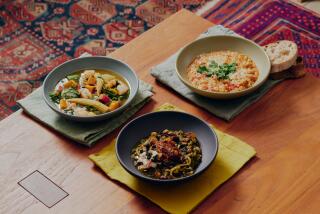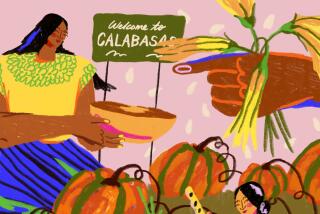Oz: The Land of the Blue Pumpkins
The Land Down Under (Australia to some, “Oz” to those in the know) is chock-a-block with oddities.
Most of us have heard that water spins down the drain counter-clockwise, that the seasons are reversed and that motorists drive on the “other” side of the road. But the strangeness goes beyond the surface. Consider that neither the kangaroo nor the emu, Australia’s official fauna, is capable of moving backwards (my kind of critter).
And, best of all, in Oz, pumpkins are blue.
It’s true. South of the Equator and west of the date line, pumpkins are blue--and they’re found everywhere. Which doesn’t make sense at first glance, since pumpkins are a native New World food.
Pumpkins had been harvested by American Indians long before Columbus and are, in fact, believed to have been their first cultivated crop. New England tribes called both pumpkins and squashes askutasquash, but English settlers soon shortened the foreign tongue-twister to just plain “squash.” They gave the pumpkin the name of the pumpion, an Old World gourd.
So, how did the lowly Australian pumpkin, a member of the genus Cucurbita pepo (first cousin to the squash and half-brothers to the plump orange globes with which we are so familiar), gain such a following in Oz?
On my third day Down Under, I boarded the Queenslander train out of Brisbane and headed for the tropic north. At lunch on this exquisite wooden- and crystal-appointed train, time-warped from a millionaire’s dream out of the 1940s, the menu read: pumpkin soup. Yank that I am, I ordered it expecting a cinnamony concoction. Wrong. The palest orange velvety liquid, accented by a hint of cumin and topped with creme fraiche and a sprinkling of chopped chives, tasted like a vegetable.
Next stop, Townsville, the largest city (population, 100,000) in Queensland’s tropical north. At morning tea with the city council, the tray held moist pumpkin scones, a personal recipe made famous by Queensland’s woman senator, Flo Bjelke-Petersen.
How did pumpkin carve out its niche south of the Equator, so far from home? An afternoon spent researching the history of South Pacific Commonwealth food in Brisbane’s state library revealed the answer.
The intrepid explorer Captain Cook noted this in his diary on Aug. 23, 1770, when he first made landfall at New South Wales’ Botany Bay: “The Land naturly (sic) produces hardly anything fit for man to eat and the Natives know nothing of Cultivation.”
Eighteen years later, when the First Colony Fleet landed in Sydney harbor in 1788, its crew and load of convicts had lived for eight and a half months on bread, salt pork, salt beef, dried peas, oatmeal, butter, cheese and vinegar (thought to prevent the dreaded ocean farer disease, scurvy).
But on the way the flotilla’s wise commander, Captain Phillip, had stopped at the Canary Islands, where many New World plants were first tried out for the rest of the world, and again in Rio de Janeiro. He loaded up on New World foods to supplement the salty diet of his ship’s cargo (both human and livestock) with fresh provisions, and he acquired a tremendous variety of seeds to help the colony along once it reached its destination.
By April of 1790, the colonists’ weekly rations had been reduced to two and a half pounds of flour, two pounds of rice and two pounds of pork. The rice was infested with vermin, and the salt pork so dry that it could not be boiled but was “toasted before the fire, the drops caught on a slice of bread or in a saucer of rice.”
During the hungry years of 1788 to 1792, many settlers lost the will to survive, but by 1795 more than 400 convicts had been rewarded for “industrious habits” with 30 acres each in the fertile Paramatta River valley just outside modern Sydney.
In 1830, the British author, Alexander Harris, looked down into the valley and noted that he was “in the land of the husbandman . . . whichever way (he) looked . . . fields of green Indian corn . . . pigs . . . (and all sorts of vegetables and fruit trees including) . . . pumpkins as big as a large bucket.” In fact, Harris found that the chief vegetable was pumpkin, which he preferred to anything else.
Perhaps in the Land Down Under pumpkins were only originally meant to feed livestock, but somewhere along the line a good cook or two discovered tremendous versatility in the first cultivated crop from their sister settlement, America. Today, in Australia and New Zealand you cannot pass an eating establishment without discovering some new way to prepare one of the oldest foods known to humankind.
This soup recipe comes from Queenslander Railroad Dining Service, Brisbane, Australia.
QUEENSLAND BLUE PUMPKIN SOUP
3/4 cup butter
1/2 cup chopped onion
1 teaspoon ground cumin
2 cups chicken stock
4 1/2 cups chopped peeled pumpkin
Dash ground nutmeg
1 cup half and half
1/4 cup sour cream
1 tablespoon chopped chives
Melt butter in soup pot. Add onion and saute until transparent. Add cumin and cook, stirring, 2 minutes. Add chicken stock, pumpkin and nutmeg. Cover and simmer 15 minutes or until pumpkin is tender. Puree mixture in blender or food processor. Return mixture to pan and stir in half and half.
Reheat. Pour into individual bowls. Garnish each portion with dollop of sour cream and sprinkling of chives. Makes 6 servings.
Note: For dramatic presentation, soup can be served in small bowl-size pumpkins. Cut 3-inch circle around stem, lift off and remove seeds. When ready to serve, pour soup into pumpkins and replace stem lids to keep soup hot.
Each serving contains about:
323.67 calories; 515.97 mg sodium; 80.94 cholesterol; 29.45 grams fat; 12.5 grams carbohydrate; 4.87 grams protein; 1.63 gram fiber; 81.89% calories from fat.
Senator Flo Bjelke-Petersen of Canberra, Australia made these famous moist scones.
SENATOR FLO’S PUMPKIN SCONES
1 tablespoon butter, softened
3 tablespoons sugar
1 egg
3/4 cup mashed cooked pumpkin
2 cups self-rising flour
Dash salt
1/4 cup milk
Unsalted butter
Cream butter with sugar until light and fluffy. Add egg and beat until well blended. Stir in mashed pumpkin, flour and salt. Turn dough out onto floured board and knead gently, adding just enough flour until mixture stops being sticky.
Pat dough into 12x4-inch rectangle. Cut rectangle into 2-inch squares. Place squares on baking sheet and brush tops with milk. Bake at 350 degrees 10 to 15 minutes or until raised and lightly browned. Serve with unsalted butter. Makes 12 scones.
Each scone contains about:
55.53 calories; 118.71 mg sodium; 3.27 cholesterol; 1.22 grams fat; 9.93 grams carbohydrate; 1.29 grams protein; 0.13 gram fiber; 19.77% calories from fat.
From Madonna Maris of Charleville, Australia:
SAVORY STUFFED PUMPKIN
1 (4- to 5- pound) medium pumpkin
Oil
1 large onion, chopped
1 pound mushrooms, chopped
1 pound ground beef, pork or lamb
1 teaspoon rubbed sage
1 egg, beaten
1 cup fine dry bread crumbs
Salt, pepper
3/4 cup milk
1 tablespoon cornstarch
1/4 cup warm water
Cut circle in top of pumpkin around stem. Carefully lift off stem lid. Remove seeds and set pumpkin and lid aside.
Heat 2 tablespoons oil in large skillet. Add onion and mushrooms and saute until onion is transparent and mushrooms are tender. Remove mixture and place in large bowl.
Saute meat in same skillet, crumbling with spoon, until brown. Remove meat (reserve drippings) and add to onion-mushroom mixture with sage, egg and bread crumbs. Season to taste with salt and pepper. Lightly pack mixture into pumpkin cavity and replace stem lid. Rub outside of pumpkin with little oil and place in large roasting pan. Bake at 350 degrees 1 hour or until pumpkin is tender.
Reheat skillet with drippings over medium heat. Add milk and cook, stirring, until well blended. Mix cornstarch with warm water. Add to skillet and continue to cook, stirring until thickened and smooth.
Cut pumpkin into wedges and serve with sauce. Makes 4 to 6 servings.
Each serving contains about:
431.3 calories; 163.04 mg sodium; 75.96 cholesterol; 24.35 grams fat; 26.97 grams carbohydrate; 28.48 grams protein; 2.98 grams fiber; 50.81% calories from fat.
More to Read
Sign up for The Wild
We’ll help you find the best places to hike, bike and run, as well as the perfect silent spots for meditation and yoga.
You may occasionally receive promotional content from the Los Angeles Times.






